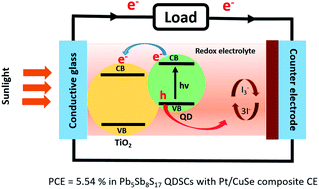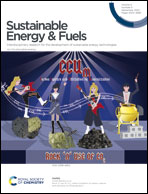Pt/CuSe: a new counter electrode for polyiodide reduction in quantum dot-sensitized solar cells
Abstract
The most common structure of a quantum dot-sensitized solar cell (QDSC) employs a metal sulfide counter electrode (CE) combined with a polysulfide electrolyte (S2−/Sn2−). Polyiodide electrolytes (I−/I3−) have an advantage over polysulfide because of their high photovoltage output. However, most semiconductor QDs will dissolve in polyiodide. This work presents a new double-layer CE material Pt/CuSe that is compatible with polyiodide. The electrocatalytic activity of three types of CEs: Pt, CuSe and Pt/CuSe, are compared using cyclic voltammetry, Tafel plots and electrochemical impedance spectroscopy. Among the three CEs, the Pt/CuSe CE exhibits the best catalytic activity with low charge transfer resistance and a high current density. Pt/CuSe CEs are then applied in ternary Pb5Sb8S17 QDSCs that are stable in polyiodide. The QDSC with the Pt/CuSe CE exhibits a power conversion efficiency (PCE) of 3.71% (with ZnS passivation), which is significantly higher than those of cells with Pt (2.53%) and CuSe (2.68%) CEs. At the reduced intensity of 0.1 sun, the PCE further increases to 5.54%, a respectable efficiency for a QDSC. To the best of our knowledge, Pt/CuSe is the first CE for QDSCs using polyiodide and has the potential for improving performance in QDSCs.



 Please wait while we load your content...
Please wait while we load your content...